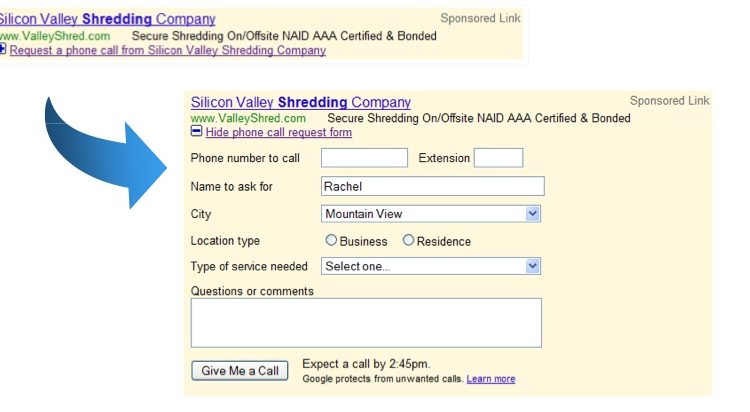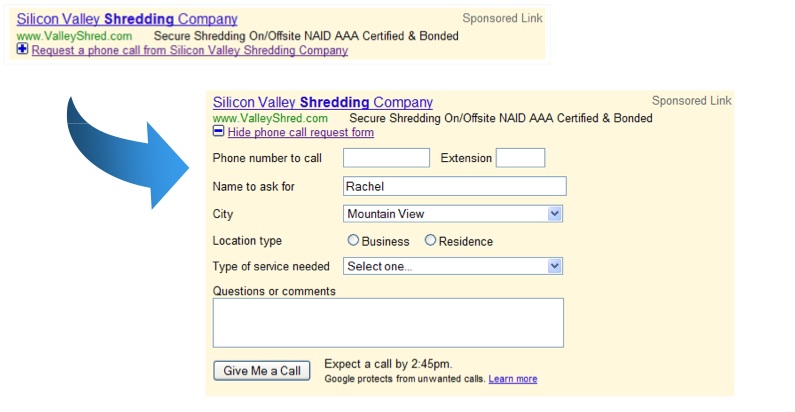We have been quite busy at the labs here, but I wanted to cover a PPC development that blipped on our radar earlier this year. For many of us, PPC is a critical source of traffic, and can be quite the task to manage. Well to add to the list of things to consider, Google is beta-testing the collection of phone lead information directly from SERPs (Search Engine Results Pages).
Google generates roughly 97% of its revenue from online advertising, so it makes sense that they delve into new areas of online marketing – which now seems to include part of the sales process as well.
Given the huge potential (or threat) this represents to you, the Internet marketer, I think this is a vital development to cover on this blog (and even reached out to a search engine marketing firm to get their ideas for you as well.) While this will not affect all verticals, for some niches this might pour some gasoline (or more correctly napalm), on already very competitive areas.
So how does it work?
According to Amber from PPC Hero, “The gist of the beta is if you’re running a PPC ad in Google, and you’re in the top position, you can click on a plus sign next to a call to action (the name you give your contact form) and Google will drop down your contact form to be submitted right there in the Google search results.”
Here is an image from that article to show the lead collection:
It’s important to note that, as with all things in beta, this has the potential for change, as I believe Google does do some testing from time to time.
And since this new feature is currently in beta, limited to businesses appearing in position #1 of PPC results, and on select keywords, it may not be available to you yet. If you’re interested, the best person to contact is your friendly Google rep.
More importantly…how can I make it work for me?
While I think this could have potentially large ripples in certain areas of online marketing, I wanted to have a chat with our friends at ROI Revolution, and get another viewpoint as well.
As a quick background, ROIRevelution is a company whose main area of focus is in pay-per-click management and they are quite good at it. We had the chance to speak with PPC Account Manager Mike O’Rourke. Here are just a couple of points Mike and I discussed:
Upsides
- Simplifies the conversion process.
- No friction (and lead loss) from weak landing pages.
- Great tracking for businesses that use the phone a lot, a traditional weakness of current PPC tracking solutions. Interesting, how could this be applied to other voice communication/VOIP solutions like Google Voice?
- The feature will be good for certain verticals (e.g., plumbers) that provide local services tied to specific keywords (e.g., “broken pipes”).
Downsides
- Can’t have a conversation in a PPC ad. Landing pages provide a good service for addressing anxiety and questions. So how effective will this lead capture be?
- Opportunities to increase the value of a lead with a well-optimized funnel are lost (e.g. upsells). Without the ability to do that how valuable will the leads really will be?
- Because conversion is expected on the search page, you do not have their undivided attention. On a landing page, you can guide their thinking.
- Maximum cost-per-click (CPC) rates are applied to leads submitted. This will likely cause your cost per acquisition to rise.
- Since you must in position #1, the bids for the top position might heat up significantly.
- Many people also now use many CRM solutions for keeping track of customers and sales. Will this information be easily integrated with common solutions or sent to advertisers in a standardized way?
Won’t you tell me your name? I love you. Hello.
Personally, I am interested in seeing are how users respond to putting their information directly into a form on a search engine results page. While I think some users are very trusting, others might be turned off by your attempt to get their number so soon.
It might seem like an out-of-sequence conversation. As Flint McGlaughlin, the director of MECLabs Group (our parent company) describes trying to ask for a lead to early in the process, “You don’t ask a girl for a kiss before you have a date with her.”
That might seem kind of corny. But think about how you handle your own phone number. Many of us treasure our phone numbers and can guard them quite fiercely. Will a relatively short ad space be enough to capture users and convince them to give up this information? Are you asking for too much, too soon?
Also, some of the things we talk about in great detail here are anxiety and value proposition. While you can address these with your ad copy in a limited fashion, the fact remains you only have so many characters to work within.
Your pay-per-click ad copy and the space search providers give you is simply to get the conversation going – address why they should click, how you are meeting their motivation, and then get them to a landing page to do the heavy lifting.
In skipping that step, you can end up with spending a lot of money (especially by paying max CPC) with leads that are not as qualified or do not convert.
Also, since this is a new technology, you might be getting a fair amount of people using it because they wanted to see how it works, rather than being genuinely interested in your message.
I have some more thoughts on this that we will post soon, but I want to get your opinion on what impact, if any, you think this new Google innovation will have?





The shredding ad in the above example is not very effective. I would test some ad copy that includes a clear call to action and leads them into the process. Also, I suspect this type of lead gen will perform better in verticals where there is a greater sense of urgency.
What would be really cool is if you could embed this form on your website. Most small business owners have terrible contact forms if any at all. That way, if you don’t get the lead from the initial “plus box”, you can still capture it on your site after the click.
I can’t wait for Google to integrate Analytics, Adwords (including this phone lead program) and Google contacts to build some kind of poor mans CRM.
@Aaron
I would agree there is some things left to be desired. Also, we have to consider that your ad copy will have competing objectives in this instance. Do you optimize the copy for clicks to the landing page, and hopefully get some calls? Or do you go after the calls but then you will lose out on the people that could convert really well on the landing page. Oh yea and remember, you have a really small amount of characters to work with.
I think your point about embedding the form is really on point. I do a lot of pro-bono work for smaller businesses and this is consistently a hurdle to overcome. It would be really neat to integrate this with some customization options, and even have some small testing capabilities through a GWO type system.
@Tom
Honestly, I think this is the route they are going to try and shoot for in the future. Or I see them buying a company to help them close the really small gap that exists now.
Great feedback thus far, let’s keep it going.
One of the biggest issues with this format is that users aren’t accustomed to interacting with ads on SERPs (clicking the plus sign). Therefore, most won’t even know they could fill out a contact form right on the SERP. While an interesting test I still think that Google will need to refine this a lot before it gets a large roll-out.
It’s true that, asking too much too soon, and again it depends from user to user, how comfortable are they or business oriented to have their number be entered online in google, and also it stops to collect analytical data too. But in a way, new innovations have always got pros and cons, and need to find out, how to convert cons to pro again and build up the faith and business objectives.
I believe this feature has a big potential in the near future, even though I can’t help but wonder how far Google will go to keep users from ever leaving his sites. Rich text snippets, on-SERP’s contact form, maybe the next step will be to open every site in a frameset with Google on top?…
I dont think people will have issue with new ads. If they do “old” version will still be available for them. I would not mind doing some stuff from the SERP instead. I still dont understand why Google is trying to keep people longer on their website. If they did search and then clicked what else they gonna do?
@nermin hadzikadunic
One of the biggest issues with this format is that users aren’t accustomed to interacting with ads on SERPs (clicking the plus sign).
Hi Corey,
Great post! Thanks for sharing this valuable information. It creates a better opportunity to understand PPC management.